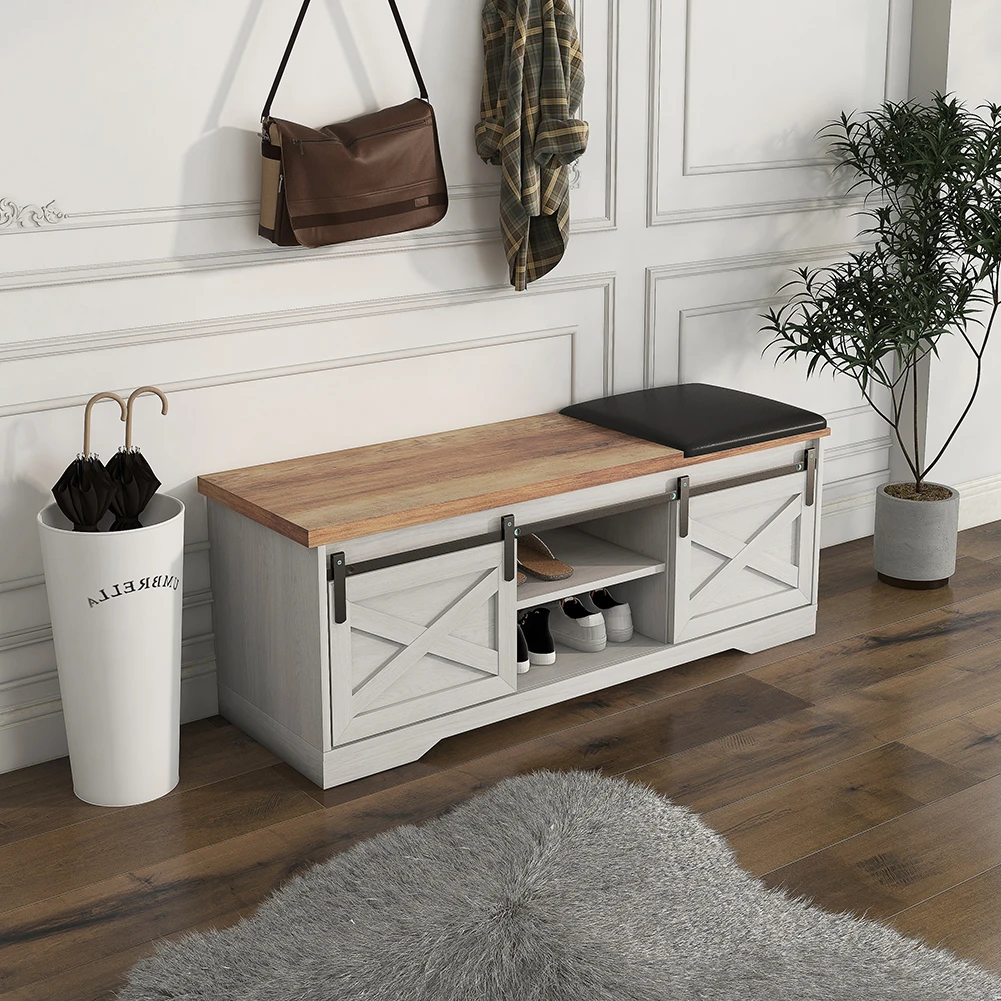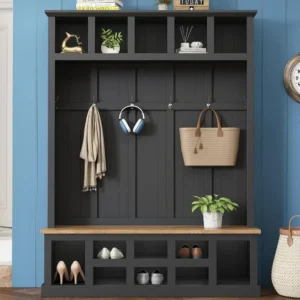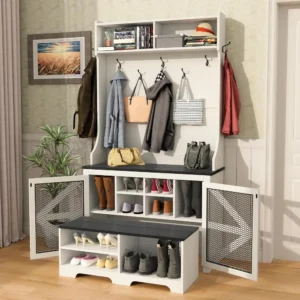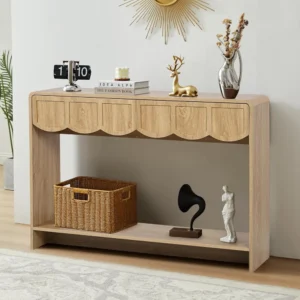Introduction: The Challenge and Importance of Space-Efficient Mudroom Storage
Walking into a cluttered entryway sets the wrong tone for your entire home. In today’s living spaces, particularly in urban areas, entryways are often limited to just 12-36 square feet—barely enough room to open the door and step inside, let alone store all your family’s shoes, coats, and bags.
Yet these small spaces shoulder a heavy burden: they’re the first line of defense against household chaos. When your entryway lacks proper organization, that disorder inevitably spreads throughout your home, creating frustration and wasted time searching for essentials.
This is where space-efficient mudroom benches shine, serving the dual purpose of providing a comfortable spot to put on shoes while cleverly incorporating storage solutions designed for limited square footage. The right bench can transform even the tiniest entryway into an organized hub that contains clutter and simplifies your daily comings and goings.
Seasonal challenges make these solutions even more crucial—winter brings bulky coats and boots, spring introduces umbrellas and raincoats, while summer and fall bring their own unique storage requirements. Finding smart ways to transform entryway space-saving benches into functional command centers requires thoughtful consideration of available options.
In this guide, we’ll explore the most effective space-efficient mudroom bench solutions, from floating designs to corner units, helping you discover the perfect option for your small entryway.
Key Considerations When Selecting a Space-Efficient Mudroom Bench
Before diving into specific bench types, understanding what makes a bench truly “space-efficient” will guide your selection process:
Precise Measurements Matter:
* Depth requirements: A minimum of 12 inches provides comfortable seating, though 14-16 inches is ideal if space permits
* Width options: Consider available wall space; as little as 24 inches can work for single-person seating
* Height standards: 17-19 inches offers the most comfortable seating position for most adults
* Clearance needs: Allow at least 24 inches in front of the bench for comfortable movement
The perfect balance between seating capacity and storage requirements depends on your household’s unique needs. A single person might prioritize style over extensive storage, while a family of four requires significantly more organizational capacity in the same footprint.
Material selection significantly impacts both durability and maintenance in these high-traffic areas. Solid wood offers timeless appeal but may require more care, while metal frames with composite components often provide better resistance to daily wear and tear.
Your complete guide choosing compact bench options should also account for design harmony with your existing décor. The entryway sets the tone for your entire home, so consider how materials, colors, and styles flow into adjacent spaces.
Budget considerations must be weighed against material longevity—investing in quality construction pays dividends through years of daily use. Understanding the perfect entryway bench height and proportions ensures both comfort and functionality in your specific space.
Floating and Wall-Mounted Benches: Maximum Floor Space Efficiency
When floor space is at an absolute premium, floating and wall-mounted benches offer elegant solutions that create the illusion of more room while providing essential functionality.
These space-saving marvels attach directly to wall studs, eliminating legs and keeping valuable floor space clear. This unobstructed floor view makes small entryways appear larger while making cleaning underneath effortless. For the most compact spaces, shallow-depth options (as narrow as 10 inches) still provide functional seating while projecting minimally into the room.
Key advantages of floating benches include:
- Visual lightness that makes small spaces feel more open
- No legs to navigate around when entering with bags or packages
- Adjustable height installation to perfectly match your family’s needs
- Design versatility ranging from sleek, minimalist planks to more traditional styles with decorative brackets
When considering a floating bench, proper installation is critical—these units must be securely anchored to wall studs to support both seated weight and storage items. Most quality options support 250-400 pounds when properly installed.
The space beneath floating benches creates valuable additional storage opportunities. Options include:
* Decorative baskets for shoes or accessories
* Pull-out shoe racks that slide away when not needed
* Pet bed areas that utilize otherwise wasted space
* Seasonal storage containers that can be easily swapped
With prices ranging from $150-350 depending on materials and features, floating benches offer exceptional value by maximizing functionality in minimal space.
Slim-Profile Hall Trees: Vertical Storage Maximization
When horizontal space is limited but vertical wall space is available, slim-profile hall trees provide comprehensive entryway organization by building upward rather than outward.
These space-efficient solutions combine multiple functions—seating, hanging storage, and compartments—into unified structures that typically extend 12-18 inches from the wall while utilizing 5-7 feet of vertical space. This integrated approach eliminates the need for separate furniture pieces that would consume valuable floor area.
The genius of slim-profile hall trees lies in their vertical storage configuration:
- Upper sections provide shelving for less-frequently used items
- Middle sections feature hooks at various heights for coats, bags, and accessories
- Lower sections incorporate bench seating with shoe storage underneath
Many entryway hall tree options feature narrow profiles specifically designed for tight spaces, with some models as slim as 12 inches deep while still providing all essential functions. The vertical design naturally draws the eye upward, making low ceilings appear higher and small spaces feel more expansive.
For awkwardly shaped entryways or spaces with limited wall availability, corner hall tree models transform underutilized corner spaces into functional organization centers. These units follow the same vertical storage principle but with angled designs that fit snugly into corners.
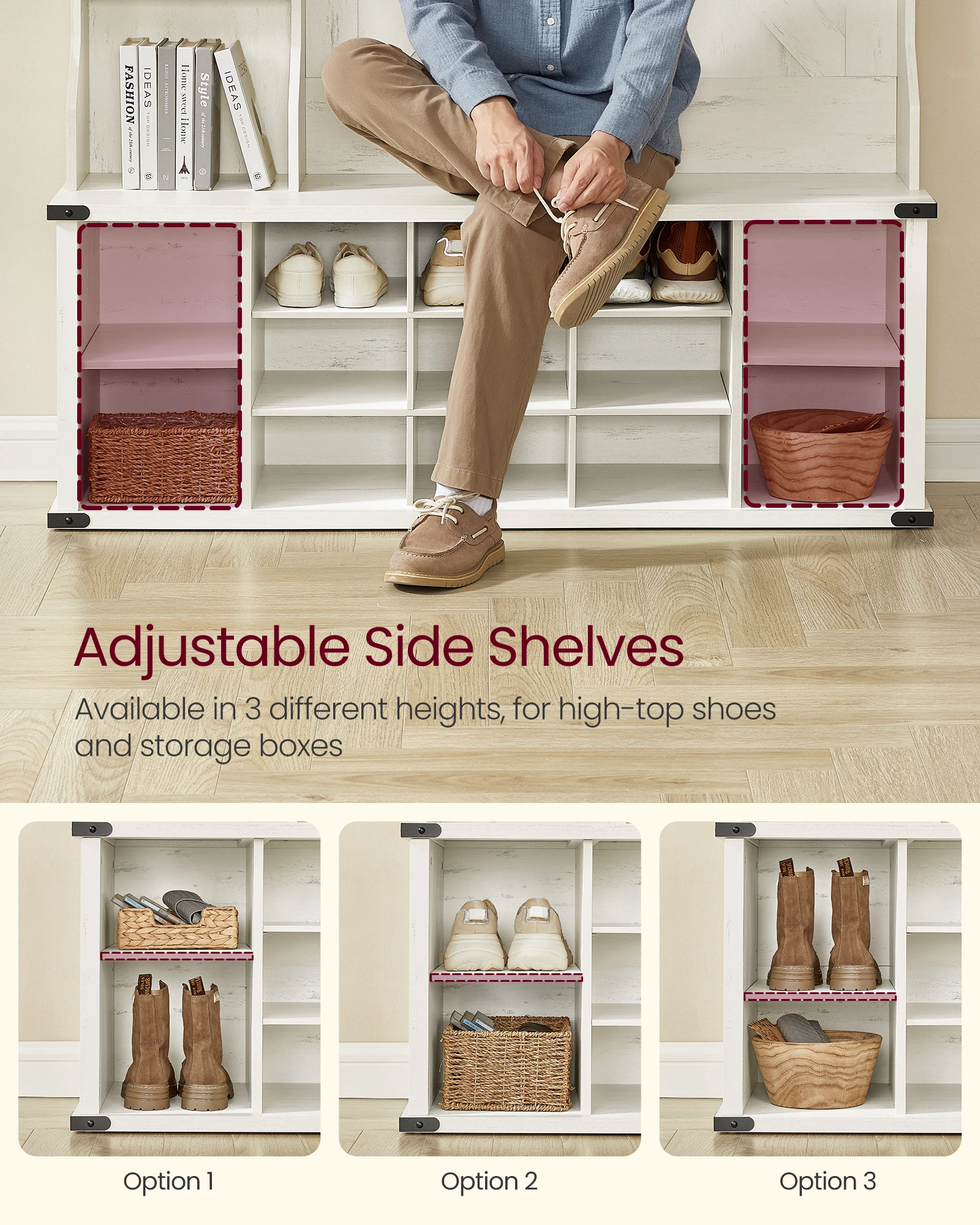
When selecting a slim-profile hall tree, consider both seating weight capacity (typically 200-350 pounds) and hook weight limits (usually 5-15 pounds per hook) to ensure the unit meets your household’s specific needs.
Corner Mudroom Benches: Utilizing Overlooked Spaces
Corners represent some of the most underutilized real estate in small entryways, yet they offer tremendous potential for space-efficient organization when properly furnished. Corner mudroom benches transform these awkward angles into functional seating and storage hubs.
These specialized benches come in two primary configurations:
- L-shaped designs that follow the corner contours, providing extended seating along two walls
- Triangular units that fit precisely into corners with minimal projection into the room
The geometric advantage of corner benches becomes evident when comparing floor space usage: a standard linear 48-inch bench consumes about 8 square feet of floor area, while a corner bench offering similar seating might use just 5-6 square feet by utilizing the otherwise wasted corner space.
Design features unique to corner units include:
- Angled shoe storage compartments that maximize organizational efficiency
- Specialized corner hooks or shelving that utilize the full depth of corner spaces
- Tapered bench surfaces that provide comfortable seating while minimizing floor projection
For those with particularly challenging spaces, exploring the ultimate guide space-efficient corner bench options reveals specialized solutions like floating corner benches that preserve floor space while still utilizing corner walls.
Our collection of corner entryway bench solutions includes various sizes and configurations suitable for both tight corners in narrow hallways and more spacious entryway corners that can accommodate larger organizational needs.
When measuring for a corner bench, remember to account for baseboard projection and any nearby door swing patterns to ensure proper fit and functionality in your specific space.
Storage-Optimized Benches for Small Spaces
The internal configuration of your mudroom bench dramatically impacts its storage efficiency. Different designs excel at organizing specific types of items, so matching the storage style to your household needs maximizes functionality in minimal space.
Lift-Top Benches
These ingenious designs feature hinged seats that reveal large-volume storage compartments perfect for bulky seasonal items, sports equipment, or rarely used gear. The clean exterior appearance maintains visual simplicity in small spaces while hiding considerable storage capacity beneath.
Key advantages include:
* Maximum volume storage in minimal footprint
* Completely hidden contents for a tidier appearance
* Protection from dust for stored items
Modern lift-top benches feature hydraulic or gas-lift hinges that make access safe and effortless, even with heavy lids. Some models incorporate divided internal compartments for better organization of different item categories.
Drawer-Based Benches
For households needing frequent access to smaller items like gloves, scarves, keys and mail, drawer-based storage provides superior organization with easy visibility and access.
Our entryway bench drawers collection includes options with:
* Full-extension drawers for complete visibility of contents
* Partial-extension designs that require less clearance in tight spaces
* Multi-drawer configurations for family-member-specific organization
* Soft-close mechanisms preventing slams in small spaces
The structured organization of drawers prevents small items from becoming lost or damaged—a significant advantage over open storage for accessories and daily essentials.
Open Cubby Benches
For shoe storage and frequently accessed items, open cubby designs offer exceptional functionality:
* Direct visibility of contents without opening compartments
* Air circulation preventing odor buildup in shoe storage
* Customizable organization with optional bins and dividers
* Quick access for items used during daily transitions
The mudroom bench shoe storage options include specialized designs with shoe-specific cubbies sized for different footwear types, from children’s sneakers to adult boots.
Combination Storage Types
The most versatile space-efficient benches incorporate multiple storage methods within a single unit:
* Upper drawers for accessories paired with lower shoe cubbies
* Side cabinets combined with central open storage
* Lift-top sections alongside fixed open compartments
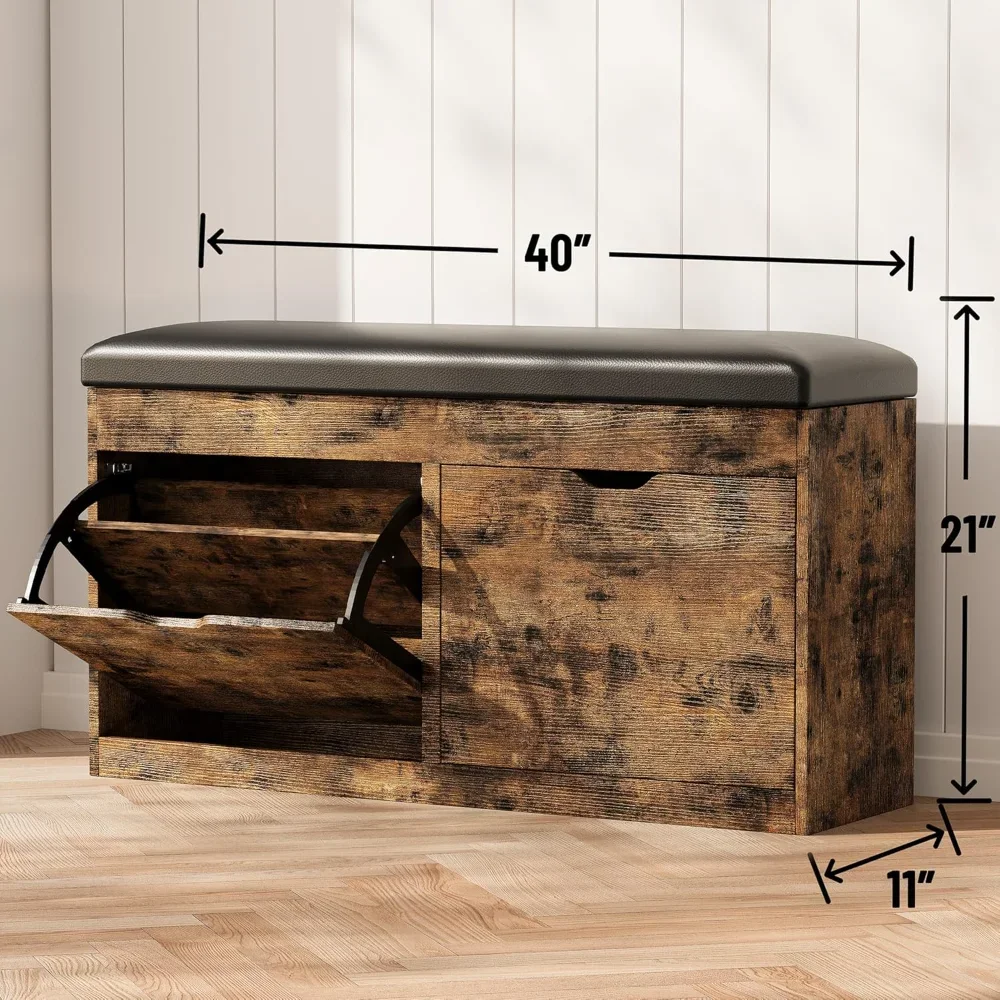
These hybrid designs allow customization to your specific organizational needs while maintaining a compact footprint suitable for small entryways.
Narrow Entryway Benches for Ultra-Tight Spaces
When dealing with extremely limited entryway width—such as in apartment hallways or narrow corridors—specialized ultra-slim bench designs become essential. These purpose-built pieces maintain functionality while projecting just 8-12 inches from the wall.
In these challenging spaces, every inch matters. Consider these approaches for maximizing extremely narrow entryways:
- Prioritize the most essential functions first (typically seating and shoe storage)
- Select backless designs that can slide partially under console tables when not in use
- Choose models with vertical storage components that compensate for limited floor footprint
- Utilize visual tricks like leggy designs and light colors to minimize visual weight
For hallways under 3 feet wide, traditional benches often won’t work at all. Alternative approaches include:
- Wall-mounted flip-down seats that fold away when not in use
- Staggered individual seating cubes rather than continuous benches
- Streamlined shoe cabinets with small seating pads on top
Many space-saving entry benches small homes incorporate clever design elements like tapered profiles, angled legs, or asymmetrical layouts that accommodate tight spaces without sacrificing function.
Our collection of narrow entryway bench options includes specialized designs with depths as narrow as 8 inches that still provide functional seating and storage in the most challenging spaces.
Maximizing Functionality: Accessories and Add-ons
The functionality of space-efficient mudroom benches can be dramatically enhanced through thoughtfully selected accessories that expand organizational capacity without requiring additional floor space.
Under-bench Solutions
- Pull-out bins and baskets: Slide-out storage containers that roll on castors or glides under bench seating
- Boot trays: Shallow, waterproof containers that collect dirt and moisture from wet footwear
- Shoe racks: Tiered organizers designed to maximize footwear storage in minimal footprint
- Rolling storage carts: Mobile organizers that can be pulled out for access and tucked away when not needed
Above-bench Components
- Wall-mounted hook systems: Various configurations of hooks installed at different heights for coats, bags, and accessories
- Floating shelves: Streamlined storage surfaces for frequently needed items and decorative elements
- Mail organizers and key hooks: Specialized wall-mounted units for daily essentials
- Hat and accessory racks: Purpose-built solutions for seasonal headwear and gear
Side Accessories
- Umbrella stands: Slender containers that corral wet umbrellas away from seating
- Narrow cabinets: Slim storage units that extend organizational capacity vertically
- Mirror integration: Space-enhancing reflective surfaces that also serve practical functions
- Wall-mounted shoe racks: Vertical storage that frees up under-bench space for other items
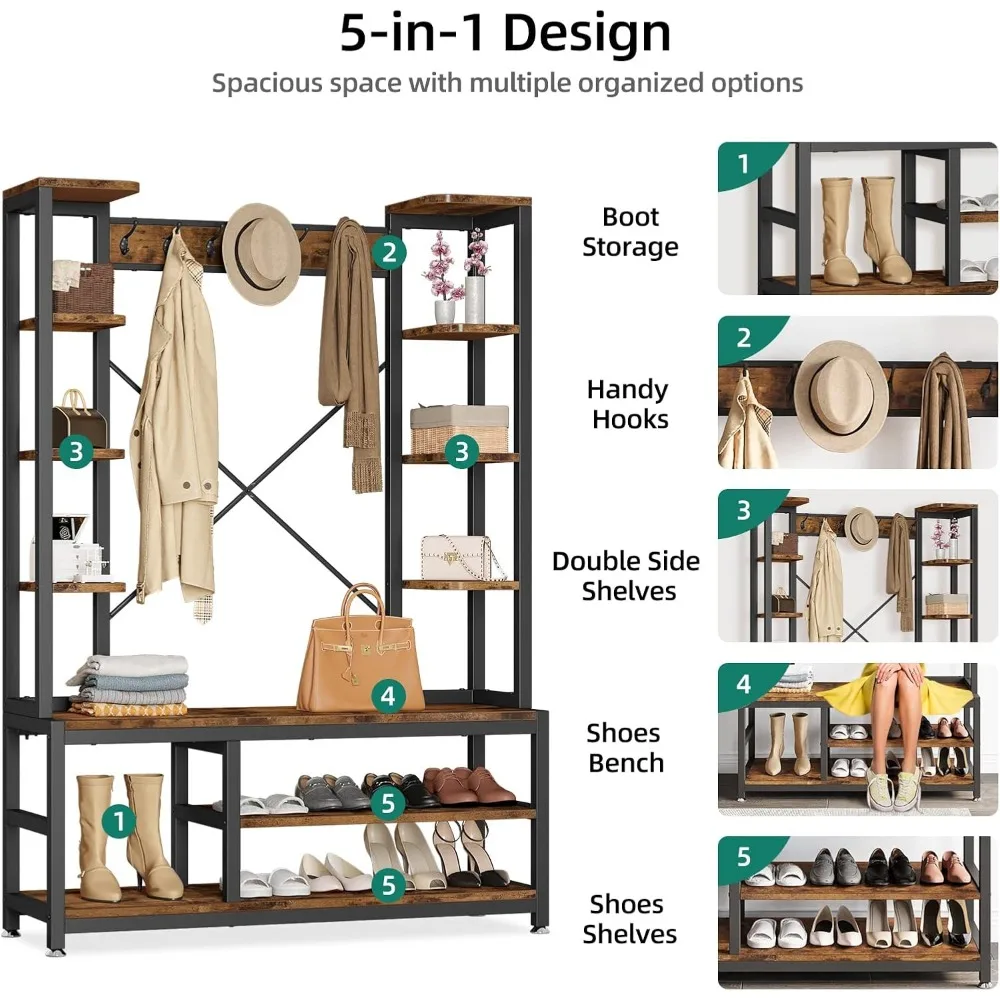
Coat Rack Shoe Bench, Corner Entryway Bench, Corner Hall Tree, Shoe Bench for Entryway
$313.58 Select options This product has multiple variants. The options may be chosen on the product pageCorner Entryway Bench, Entryway Bench with Cushion, Modern Entryway Bench, Shoe Bench for Entryway
$476.34 Select options This product has multiple variants. The options may be chosen on the product pageBench with Hooks and Storage, Entryway Hall Tree, Mudroom Bench with Cubbies, Mudroom Bench with Shoe Storage
$818.38 Select options This product has multiple variants. The options may be chosen on the product pageEntryway Coat Rack Bench, Entryway Hall Tree, Farmhouse Mudroom Bench, Mudroom Bench with Shoe Storage
$805.09 Select options This product has multiple variants. The options may be chosen on the product pageBench with Hooks and Storage, Entryway Coat Rack Bench, Entryway Hall Tree, Mudroom Bench with Shoe Storage, Mudroom Coat Rack Bench
$793.73 Select options This product has multiple variants. The options may be chosen on the product page- Price range: $785.40 through $897.63 Select options This product has multiple variants. The options may be chosen on the product page
When selecting accessories, maintain consistent design elements like matching hardware finishes and complementary materials to create a cohesive look despite the multiple components.
Custom-Built Solutions for Challenging Spaces
When standard mudroom bench options don’t align with your unique spatial challenges, custom-built solutions offer tailored functionality perfectly matched to your specific entryway dimensions and needs.
Custom solutions excel at:
- Fitting irregular wall shapes or angled entryways
- Navigating around immovable obstacles like radiators or electrical panels
- Utilizing recessed areas between wall studs for added depth
- Incorporating existing architectural features into the design
- Maximizing every available inch in unusually shaped spaces
The primary decision when considering custom options is between built-in (permanently installed) and custom freestanding pieces. Built-ins offer maximum space efficiency and stability but require more substantial investment and commitment, while custom freestanding pieces provide flexibility for future changes.
Material selection for custom projects should prioritize durability in high-traffic areas—solid hardwoods, quality plywood with proper edging, and moisture-resistant finishes stand up best to entryway demands.
For those with basic woodworking skills, DIY mudroom benches limited spaces can be achieved using modified cabinetry, repurposed furniture, or simple construction techniques. The DIY approach allows for precise customization to your specific space constraints and organizational priorities.
Professional custom solutions typically range from 1.5-3 times the cost of comparable pre-manufactured options but deliver perfect fits and tailored functionality impossible to achieve with standard pieces.
Material Selection for Durability and Space Enhancement
The materials you choose for your space-efficient mudroom bench significantly impact both its visual presence and long-term performance in your entryway.
| Material | Visual Impact | Durability | Maintenance | Best For |
|---|---|---|---|---|
| Solid Wood | Warm, substantial | High with proper care | Moderate (occasional refinishing) | Traditional homes, long-term investment |
| Engineered Wood | Consistent, versatile | Medium | Low (simple cleaning) | Budget-conscious, painted finishes |
| Metal Frame | Light, contemporary | Very high | Low (wipe clean) | Modern aesthetics, maximum visual lightness |
| Upholstered Elements | Soft, inviting | Medium (depends on fabric) | Moderate (regular cleaning) | Comfort priority, sound dampening |
| Glass/Acrylic Components | Reflective, expansive | Medium | High (shows fingerprints) | Visual expansion of space |
In small spaces, material choices significantly affect spatial perception:
- Light-reflective surfaces like glossy finishes, glass, and mirrors bounce light and create a sense of expanded space
- Visually lighter materials such as metal and glass appear to occupy less space than solid wood
- Consistent flooring that continues under bench seating creates visual flow and perceived spaciousness
- Leggy designs that show floor underneath reduce visual weight compared to solid-to-floor cabinetry
For unconditioned or damp entryways, prioritize weather-resistant materials like powder-coated metal, marine-grade plywood, or composite materials that withstand moisture fluctuations without warping or degradation.
Visual Design Principles for Small Entryways
Strategic design choices can make even the smallest entryway feel more spacious while maximizing functionality. Apply these visual principles when selecting your space-efficient mudroom bench:
Color Selection: Light, neutral colors visually recede and make spaces feel larger, while darker tones add depth but can make spaces feel smaller. In extremely tight entryways, matching the bench color to the wall color creates a cohesive look that expands perceived space.
Proportion and Scale: Choose bench proportions that respect the overall dimensions of your space—oversized pieces overwhelm small areas regardless of their actual footprint. Look for slender profiles, tapered legs, and appropriate height-to-width ratios that maintain visual harmony.
Visual Weight Balance: Distribute visual elements evenly to prevent the space from feeling lopsided. If using a substantial bench, balance it with lighter elements elsewhere in the entryway to maintain equilibrium.
Light Reflection Strategies: Incorporate reflective elements like mirrors, glass, or metallic finishes to bounce light and create the illusion of expanded space. Position these elements to reflect the most attractive views or natural light sources.
Design Cohesion: Ensure your entryway design elements connect visually with adjacent spaces through consistent color schemes, complementary materials, or repeated design motifs. This visual flow prevents the entryway from feeling disconnected from the rest of your home.
FAQ: Common Questions About Space-Efficient Mudroom Benches
Can a mudroom bench work in an apartment entryway?
Yes, apartment entryways can accommodate mudroom benches if you select appropriately scaled pieces. Focus on narrow profiles (8-12 inches deep), wall-mounted options that preserve floor space, or modular components that can be configured to your specific layout. Many apartment dwellers find bench/hook combinations particularly useful for maximizing limited entry space.
What’s the minimum width needed for a functional bench?
A functional single-person bench can be as narrow as 24 inches wide, though 30-36 inches provides more comfortable seating. For families, consider allowing 18-20 inches of width per person for comfortable seating. Remember that storage needs may require additional width beyond the minimum seating requirements.
Which bench type offers the most storage per square foot?
Vertical hall trees typically provide the highest storage-to-footprint ratio by utilizing wall height. For bench-only options, lift-top storage benches generally offer the maximum volume for their footprint since they utilize the entire interior space for storage. The most space-efficient solution often combines under-bench storage with vertical components.
How can I prevent shoes from creating odors in enclosed bench storage?
For enclosed shoe storage, incorporate ventilation through slotted doors or back panels. Additionally, use activated charcoal odor absorbers, cedar inserts (which naturally resist moisture and odors), or baking soda-based deodorizers. Removable, washable boot trays allow easy cleaning of dirt and moisture that contribute to odors.
Are wall-mounted benches strong enough for daily use?
Properly installed wall-mounted benches are extremely sturdy when anchored into wall studs using appropriate hardware. Quality floating benches typically support 250-400 pounds—more than adequate for daily use by adults. Always follow manufacturer installation instructions and use all supplied mounting hardware for maximum stability and weight capacity.
What’s better for tiny spaces: a narrow bench or wall hooks with a shoe rack?
For extremely limited spaces (under 30 inches wide), a combination approach often works best: install wall hooks at various heights for coats and bags, with a compact shoe rack below, and add a small floating corner seat for putting on shoes. This modular approach provides all essential functions while maximizing the available space better than a single bench unit could.
Creating a Functional System: Beyond Just the Bench
The most effective space-efficient entryways combine well-designed furniture with thoughtful organizational systems that accommodate daily routines and seasonal changes.
Establishing an entryway system requires understanding your household’s specific patterns:
- What items do family members use daily versus occasionally?
- When is your entryway most congested, and how can flow be improved?
- Which items consistently create clutter, and how can they be better contained?
Creating designated homes for specific items dramatically reduces entryway chaos. Even in small spaces, differentiated storage zones help maintain organization:
- “Grab and go” zone for frequently used items (keys, everyday bags)
- “Transition” zone for items moving in and out (mail, library books)
- “Seasonal” zone for current weather-related gear (easily accessible)
- “Long-term” zone for off-season items (can be less accessible)
Seasonal rotation strategies are essential for small entryways. Implementing a quarterly system to swap winter coats for summer gear or school backpacks for beach totes keeps the active storage focused only on current needs while excess items remain stored elsewhere.
Regular organize small entryway bench maintenance prevents accumulation—implement a simple 2-minute daily reset routine where family members return items to their proper locations. Weekly deeper organization prevents gradual system breakdown.
For comprehensive solutions beyond the bench itself, exploring broader space-saving mudroom solutions reveals how hooks, shelving, and specialized storage work together with your bench to create a cohesive entryway system.
As family needs evolve, be prepared to adapt your organizational system rather than assuming one configuration will work permanently. Children growing older, changes in activities, or new hobbies all impact entryway storage requirements and may necessitate periodic reassessment of your space-efficient solutions.
With the right combination of thoughtfully selected furniture and organizational systems, even the smallest entryway can become an efficient, welcoming transition space that sets a positive tone for your entire home.

